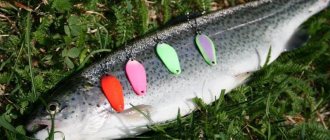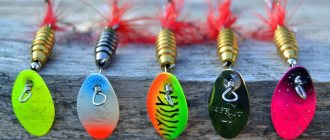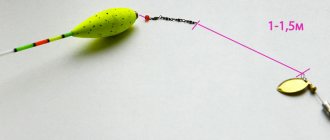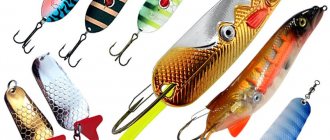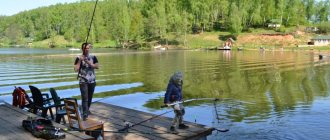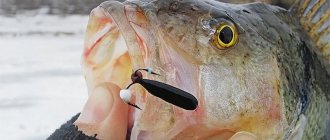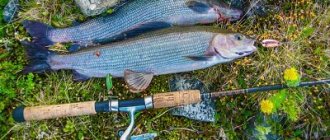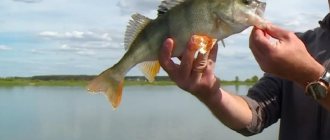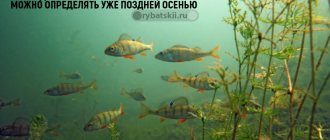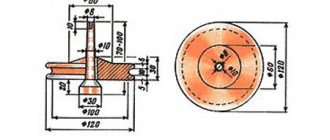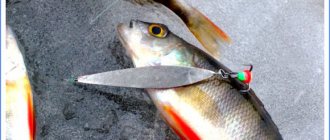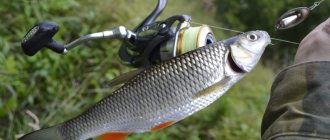Tackle
The ideal rod for catching perch with spinners is light or ultralight class. Spinner spinners for perch are baits of very light weight (2g-12g), and for their good casting and reliable control during retrieving, such light rods will be optimal.
Perch is a bold, lively, and very gambling fish. Perch fishing is very exciting - a great way to re-experience the excitement of catching predatory fish and remember the spinning skills that were slightly forgotten over the winter.
In addition, perch fishing is quite possible for beginners - there is no need to move the bait along deep-sea edges (at depths of 7 m or more) or along coastal bushes and snags, as, for example, when fishing for pike perch or pike.
In the spring, perch can be caught using many baits. It confidently grabs silicone, confidently attacks small wobblers, does not ignore simple “grandfather’s” spinner spoons (of course, small in size: 3-5cm), and also catches quite well with live bait (fry).
We will now focus on catching perch with rotating spoons (spinners). These lures in the spring give the best results when catching spring perch.
Fishing techniques in still water and currents
The rotating spoon is versatile, allowing you to fish with equal success on lakes and rivers. But depending on the depth of the water area and the strength of the current, it is necessary to choose the appropriate bait and wiring.
Stagnant bodies of water
It is easier for a beginning spinner to master fishing with a spinner in still water. For such conditions, spinners with a rounded petal shape are better suited. Mepps has models called Comet, and the famous manufacturer of artificial baits Blue Fox has developed a line of Vibrax spinners. Due to the large petal area, the turntable exhibits great resistance during wiring. And the predator clearly picks up the vibration with the lateral line from afar.
In lakes and reservoirs you can try out different animation techniques.
- Technique No. 1 is a uniform slow winding. It can be varied by changing the speed or twitching the tip of the rod.
- Front-loaded models allow you to break through deep pools or holes. The Mepps collection includes spoons called Lusox. To animate them, a step technique can be used.
Rivers
The river current has a dual effect on the operation of the turntable. On the one hand, the flow of water carries away the bait, worsening control on the part of the angler. But when fishing against the current, the petal can rotate even on a stationary bait. In reservoirs with a current, models with a willow petal, for example, Mepps Aglia Long, have proven themselves better. When rotating, they have less drag, so they are not pushed to the surface by the current.
On the river, you can use the slowest options for uniform wiring when working against the current. For front-loaded models, you can use a jig, tempting a predator at changes in depth.
Sometimes it is useful to deliberately cause the game to crash. This technique allows you to provoke a predator to attack.
fishelovka.com
Where to look for perch?
Perch is a more affordable fish than our other predators. Therefore, we do not need to climb into impassable snags, deep-sea edges, or into abundantly overgrown areas of the reservoir.
Perch can be found in sufficient quantities in relatively open areas of the reservoir. For example, on small shoots of last year's vegetation, or near a cliff (depth difference). A lot of perch usually gather near flooded trees, large flooded stumps, and snags.
The only thing you need to remember is that until the water warms up, the trees bloom, and schools of bleaks begin to hover in the upper layers of the water, you should not look for perch in the surface layers of the water. At this time, he prefers to be closer to the bottom.
From time to time, of course, you can catch perch in mid-water, and even in the surface layers. But the best results are achieved by fishing with the bait touching the bottom.
How to catch pike with a spinner
Pike fishing with a spinning rod remains not only the most exciting, but also the most effective for many anglers , and its success largely depends on the correct choice of bait. Pike spinners do not lose their popularity even with a significant increase in the range of spinners in recent years. What is the secret of her success ? How to choose the right spinner for catching river predator?
Why turntables?
- Firstly. It has long been noticed that perches have a strange love for this bait. Even those perches that, it would seem, are too early to feed on fry - weighing from 100g to 300g - are often tempted by the “spinner”. For example, from a clear stretch you can often successfully catch just such perches.
- Secondly. Even a beginner who picks up a spinning rod for the first time can fish with this bait. There is only one rule - do not speed up the pace of wiring too much. As a result, no matter how clumsily the fisherman guides this attachment, the petal will still rotate. Retrieving too quickly is the only thing that can disrupt the game of the turntable.
- Third. The fear of losing bait is not great. Yes, spinners are not that cheap (at least spinners and silicone lures are cheaper). But, at least, having torn off one spoon, we will be able to buy exactly the same one in a fishing store tomorrow.
- Fourthly. There are many options to improve the catchability of the purchased spinner. You can, for example, equip the tee with a red bead, cambric, or tie a “fly” on it. You can also add a sticker to the petal. It has been noticed that these small tricks can have a significant impact on the perch’s bite.
.IRPP_ruby .ctaButton { background-color: inherit; margin-left: 10px; position: absolute; right: 0; top: 0; } .IRPP_ruby:after { content: ""; display: block; clear: both; }
Types of spinners
All turntables are distinguished by high-frequency and active play. And this makes rotating spoons attractive baits for novice anglers, since there is no need to master the complex retrieves that are required for fishing with wobblers and some oscillating spoons. When fishing with spinners, the main thing is to take your time and maintain the speed of the retrieve. The most effective will be, rather, a slow retrieve, bordering on the mode of the spinner falling into a tailspin. It is at this border that the spoon attracts the predator most of all. But this tactic does not work for all rotating baits.
The size of the spinners is not always of great importance when catching large perch. Often humpback whales also grab small spinners, especially in places where fry gather. But if you are hunting specifically for large perch, then it is better to use larger baits. Then there will be fewer bites, but they will all bring medium and large perch.
The most universal and widespread are the turntables with a “comet” type petal. The angle of deflection of the spinner from the vertical is 45 degrees. The popular “Mepps” most often belong to this type of spinners, although this company also produces other types of spinners. Obviously, the popularity of comet-type turntables is associated with their ability to work relatively successfully in a variety of conditions, that is, in calm water of lakes, on river flows, in windy weather and waves.
Another popular and relatively universal type of spinners are long-class spinners. They are distinguished by a more elongated and narrow petal, which allows the spoon to successfully and attractively for predators pass through sections of the river with medium and strong currents. In addition, the petal’s rotation speed, which is lower than that of “comets,” as well as its deflection angle of 30 degrees, helps to cope with the current. “Comets” often cannot cope with the strong current and stop playing.
Long-type baits, meanwhile, work quite effectively in bodies of water without a current. Sometimes turntables of this type even outperform “comets”. It all depends on the fishing conditions and the preferences of the perch that day. Therefore, a spinning angler’s arsenal must include baits of different types and sizes.
Aglia type baits are the fastest. With a 60 degree blade and a higher rotation speed, these lures have even higher frequency action. In addition, they are even able to play when falling to the bottom. And this ability is used when fishing in mountain rivers .
Not so long ago, baits with a special petal coating appeared, where a 3D effect . This gives the spoon a very close resemblance to a live fish. The leadership in the production of such baits belongs to the Pontoon company.
For fishing in pits in the autumn, when bottom fishing is required, heavier jig spinners or baits with a front weight are used, where a weight in the form of a fish’s head is placed in front of the petal. Often the core is heavier than that of conventional turntables. Such baits can even be used for bottom step retrieving, as in traditional jig fishing.
Once again about the size
Pike is a fish for which the size of the bait should not be shredded.
For perch, a difference of a couple of millimeters between the lengths of the petal can be critical, but for pike it is not. At the same time, you shouldn’t rely on macro spinners, like Musky Killer and something similar. Yes, they catch pike, but with them we are talking exclusively about trophy fishing. That is, with a spinner weighing 50 grams it is incredibly difficult to catch anything less than three or four kilograms. And at the same time they practically do not increase the size of production. So, if only three-kilogram “laces” are caught on them, then there is no point in pushing further - we put fishing line No. 3-4 and continue to catch the same sizes. Moreover, what is typical is that there are often more bites.
Catching pike with poppers - in what conditions and how to properly use a surface type of gurgling wobblers.
The best spinnerbaits for pike - rating of baits and selection technique.
Perception of the spinner by the fish
Almost all predatory fish orient themselves in search of prey using the lateral line. In general, if you build a sequence in which the senses are activated, you get something like this: first the fish hears, then sees, and then grabs. What the fish perceives first is the infrasonic vibrations emitted by any object. The oscillation dynamics of the spinner are very high and therefore such a bait can be spoken of as a full-fledged search engine that collects fish from fairly large areas. Partially for this reason, some manufacturers have begun producing turntables with rattles. They differ from ordinary ones in that their core is a non-monolithic burden, but a capsule where the balls move freely. The motivation for such turntables is that they are “audible” from a greater distance and in troubled water there is nothing better than them. But this is far from true. Firstly, the fish hears not the sound of an object, but infrasound - these are very different things. Secondly, in most cases these rattles have a very negative effect on the fish. Freshwater for sure. And thirdly, the only vibrations that a fish needs are those produced by the petal. Therefore, to increase the “noise” in muddy water, simply increase the size of the spinner.
Here a question may arise about tandems and its perception by pike. They have no advantage over a conventional single-blade turntable. Unlike spinnerbaits, where two blades are a classic proven over years of positive experience, in the case of a tandem we are talking more about a marketing ploy. That is, if there is a tandem design, it is included in the model line, which to a certain extent increases the percentage of sales, nothing more.
Where and when
Although the spinner has a certain versatility of use, it cannot be used always. The period of use of spinners for pike is limited to the period of warm water. To some extent, these are the baits that turn on later than everyone else and turn off earlier than everyone else. If you focus on the numbers, then the main range of water temperature for the turntable begins and ends at approximately 7 - 10 degrees. The reason for this is that no matter how fast the spinner rotates, its vibrations are still too intense for cold water. In principle, there are cases of catching pike on a spinner at a time when there are already edges on the reservoir, but this is again a rare exception. In addition, in cold water, fish (any fish) moves less, and it is impossible to get the spinner to work at “zero” speed.
The number one reservoir for spinners can be called peat quarries and, in general, any ponds where the maximum depth rarely exceeds three meters. In such water areas, the spinner competes strongly with minnow wobblers, but in the case of pike, these two types of baits should be considered as complementary. In addition, if fishing is carried out with the expectation of a quick result, then the tactics can be as follows: we look for pike with a “fast” spinner, and catch it with a wobbler. Speed here should be considered not as fast wiring, but as dynamics. In cases where the dynamics should be high, the spinner greatly outperforms the minnow wobbler.
Sources:
https://www.fish-hook.ru/articles/klassifikaciya-vertushek-i-tonkosti-ih-provodki/ https://dlyaribakov.ru/shhuka/vertushka-shhk.html https://primanki.com/sposoby -lovli/shhuka/vertushki.html
Perception of a spinner by a pike
The very first of all the senses with which the pike is endowed, the movement of future prey is recorded by the lateral stripe on the pike’s body. With its help, the predator learns about the proximity possible victim - and only then strives to catch it in its field of view.
